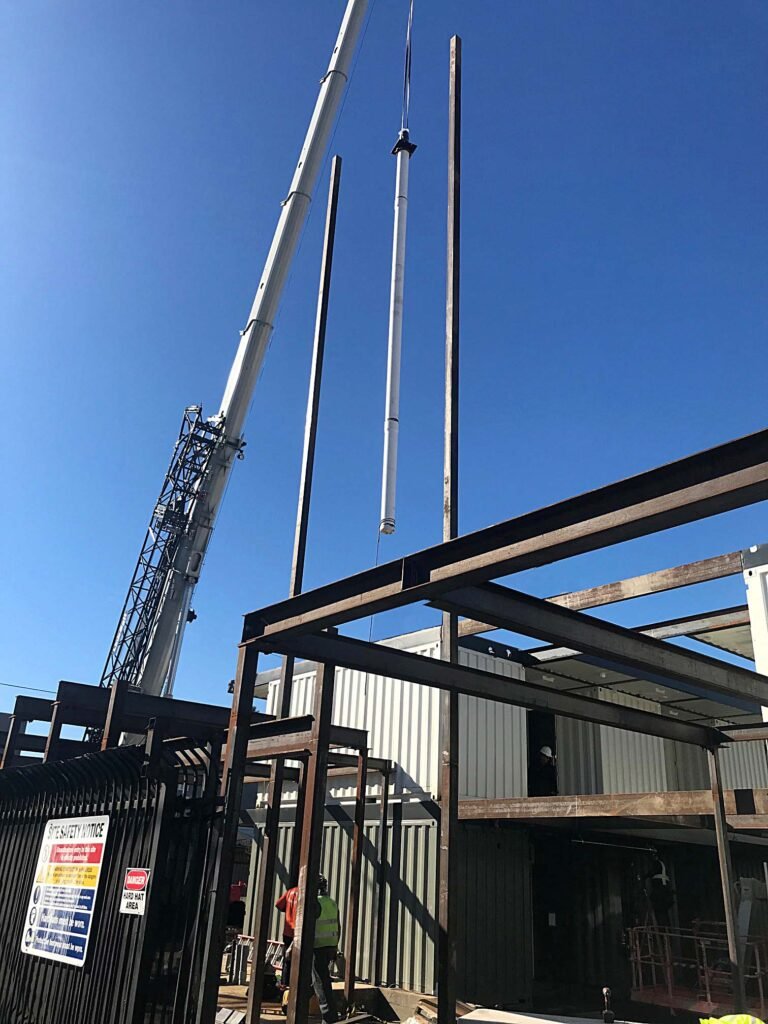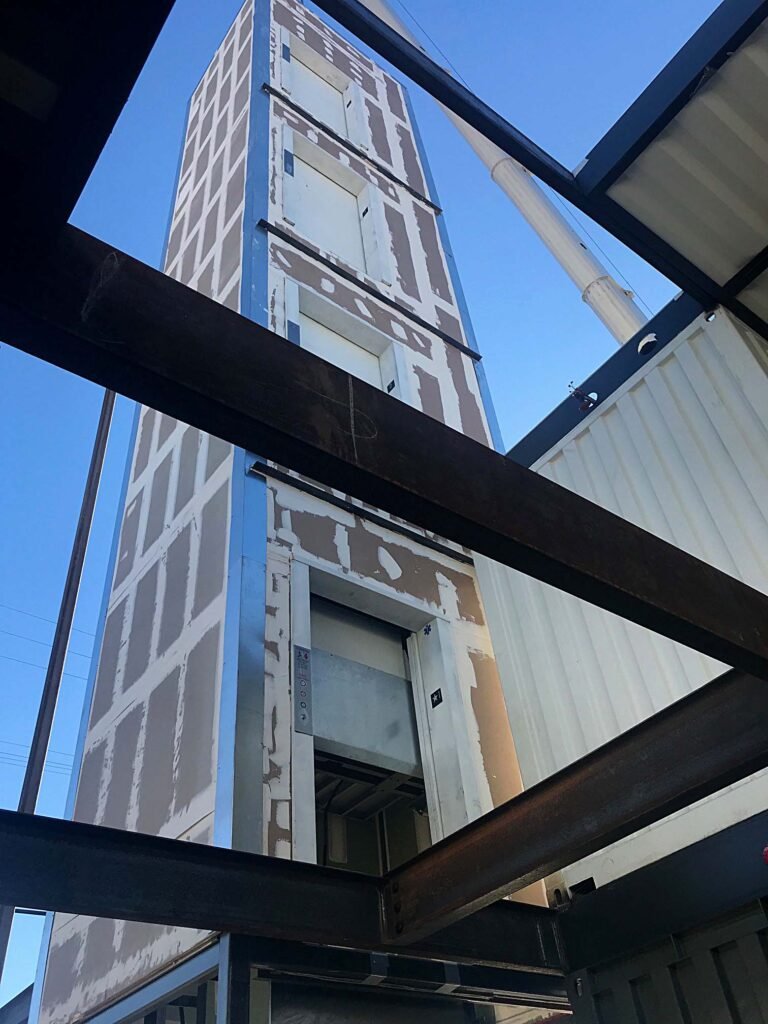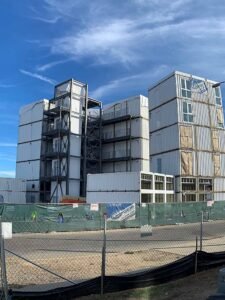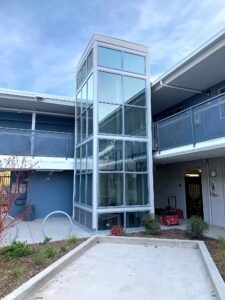


We need Supportive Housing Elevators Fast. Supportive housing is also referred to affordable housing or low income housing, but regardless of the name the need is more than evident. So, when it comes to housing the homeless, faster is better to address the issue. But also we must use the resources available in a timely fashion. Funds are being allocated to help right now. As an example the Los Angeles City Council has approved more than $51 million in financing for the construction of new affordable and permanent supportive housing developments.
But that funding can be slippery if not acted on quickly and the need could continue to go unaddressed if not used. The bottom line is that funds allocated need to result in actual building projects that are designed for housing the at risk population as quickly as possible.
And there is the problem. As everyone in the construction industry knows, a building does not pop up overnight, even when funding is approved and support is given. It takes plumbing, electric, foundation work, drawings, permits and approvals. Lastly, if over one story the project takes the slowest component of any build project, an elevator. But TLShield and Modular Elevator Manufacturing (MEM) has the solution.



Elevator Sales Executive – Christian Lahud from TLShield & Associates explains, “In traditional construction the elevator hoistway is built and sits until power is turned on at the end of the project. Then and only then elevator technicians show up. They come and go at their leisure, carrying in elevator parts and installing them one at a time until the elevator is running.” Lahud went on to say that, “The elevator and its mechanics are the first on the site and last to leave. Everything is slowed down including other trades that need the elevator installed to finish.”

The MEM Elevator System however is produced in a factory environment where a hoistway is constructed with steel. The structure is engineered to be strong enough to be self-supporting in most cases. Then all of the elevator components are installed in the hoistway in the factory.
Ultimately, when it is needed it is loaded on to a truck, shipped to the jobsite and set in place. In four hours you will have a fully installed, commercial quality elevator ready to be started up and used. It can also double as a construction elevator.
Lahud says this makes MEM perfect for the affordable housing market. “The MEM Elevator System is high-quality, but fast in setting and startup. It is a real solution where speed is of the essence to address a pressing need. No other elevator system is shipped and in place when the customer wants it.”

How do we know we are the solution? Over the decades of experience we have produced several elevators for supportive housing with just a couple of the most recent projects pictured. As you can see, whether a steel frame structure or modular structure involving storage containers, the MEM Elevator System is a perfect fit. We can be what you need regardless of the structure type. Right now due to the speed of modular construction and the immediacy of the problem there seems to be a high demand for modular structures. But another fast way to build housing is using an existing structure.
With that in mind, we are perfect for retrofit opportunities. The initial purpose of the modular elevators was to attach them quickly to exteriors of existing buildings to make them more accessible. We have grown from servicing just that market over the past 30 years, but we are still experts you can rely on if you have a retrofit project in mind.
Wrapping it all up the benefits are obvious:
It maybe time to explore the possibilities further regarding supportive housing elevators and see if the MEM Elevator System can meet your needs. You can click the button below for a Fast Track Quote for a project you currently are working on. However, if you want to explore it more, request a LIVE VIRTUAL TOUR. We would be happy to pull back the curtain and show you how we produce the industry’s most successful modular elevator solution.

The year 2020 has been a well-deserved punching bag. With the Covid pandemic, governmental mismanagement, the US election, forest fires from California to Australia, riots in American cities, airline crashes, earthquakes, tornados, volcanos, floods and even locust, it will go down as one of the worst years ever in many people’s minds. With bad things occurring in almost biblical proportions how can I blog 2020 Good News?
First, let me say I am purely looking at this from an economic perspective because without a doubt it has been a horrible year for many that have suffered with Covid or have lost loved ones.

And even sticking with just the economics let me acknowledge that for many 2020 has been a devastating mess. Especially in any small to medium sized business that thrives on in-person contact. Masks just don’t work when you are trying to eat out. Then you have all the rule changes about who can go where and do what. I am horrified to think about what the owners and employees of those businesses have been through. Beyond that, what happens if this drags on much longer? We will become a nation of chain restaurants and superstores with jobs permanently lost. The current shuttered stores will just disappear and mom and pop will simply have their hopes and dreams dashed.
However, in the macro 2020 becomes good when you look at humanities collective ability to thrive despite challenging times. Applications for business licenses are up surprising. We are a resilient bunch.
It is also good news if you are in very specific markets. Some have shown surprising growth despite all the bad news of the past twelve months. Who amongst us would not like to turn back the hands of time and buy stock in Netflix, Zoom, Dominoes Pizza or any number of pharmaceutical companies. They are unapologetic winners. This past year has not been bad for many with often the opposite being true.
Modular Elevator Manufacturing thankfully falls into the category of 2020 winners despite the challenges. It begins with the fact that most building and manufacturing was considered essential when others were forced to shutdown. And then generally the entire modular industry is on a continued, decades long upswing. As stated in the recent 2020 Smart Market Report for Prefabrication and Modular Construction by Dodge Data and Analytics:
Prefabrication and modular construction are both experiencing a significant expansion of interest and use as the construction industry seeks to improve safety, productivity, quality, cost, schedule and sustainability performances while continuing to face workforce shortages, cost uncertainties and other challenges.
Stephen A. Jones – Senior Director Industry Insights Research/Dodge Date and Analytics
We at MEM can anecdotally confirm the data put forth by the experts. There was a “significant expansion of interest and use”. In the year 2020 Modular Elevator Manufacturing doubled (yes doubled) sales and production. Vice President of Sales and Marketing, Hugo Beltran is proud of the accomplishment. He said, “The 2020 results are astounding and as a result we’ve had to double the factory space and output capacity. And amazingly we are projecting another doubling for 2021 based on projects already in our pipeline.” 2020 good news!
Although, Beltran would like to take credit for all the growth, he recognizes there is more at play. His team was crucial to success, but there was more. He said, “The construction industry is looking for real solutions to real problems.” And “There are economic and market fundamentals assisting us as the modular industry addresses those problems. So hard work by the MEM employees and the needs of the construction sector are pushing us forward in hitting all-time highs.”
Those needs as echoed in the Dodge report are: cost predictability, improved quality, improved safety, increased schedule certainty, and reduced waste. MEM is simply taking advantage of the opportunity by providing real solutions to longstanding problems in construction. But meeting needs must be more than marketing gimmicks or props in a storefront window or the growth will not accompany the construction market move to modular solutions.
That is why in the modular elevator segment, some flourish and prosper like MEM, while others struggle. While some have to explain away shoddy work and poor engineering. MEM demonstrates what decades of experience can provide with superior service, workmanship and engineering. It is why some struggle with growth despite a market that is booming. While at the same time MEM discusses a Midwestern facility to meet national sales demand. MEM can say 2020 good news (at least in some respects), others are just glad to see it go.
Hopefully for all 2021 will mean a return to more prosperous times and not just some segments. But one thing for certain, if predictions are anywhere close to correct and the market continues to embrace modular solutions in construction, MEM will be a leader in the elevator industry with more growth yet to come.
If you want to be a part of the solutions provided by the modular industry we are willing to help. We will answer any of your questions and provide a Fast Track quote. If you have a low or mid-rise project just contact us. Click the button below and fill out the information. A quote will be prepared and sent to you within 24 hours.

Speedy Multifamily Elevator Solution. One of the ways that young Americans have influenced the construction industry is that lately they have been prone to delay home purchases. This can be attributed to many factors including high prices for home ownership, a lack of the needed down payment and a delay in marriage and family. So, when they do leave their parent’s basement, generally they are renting in large numbers and not looking for the white picket fence.
The result is in many medium and large municipalities there is a predictable shortage of rental units and ultimately price inflation. Hence the multifamily building boom.
Governing.com demonstrates this through statistical data. They report that between the year 2000 and April of 2019 there was, “a median increase in the renter population of 31 percent…Over the same period, the number of owner-occupied dwellings also rose, but only by a median of 7 percent.”
That means building multifamily units is needed and needed fast. That need is further demonstrated by the recent number of multifamily unit starts as the market moves to fill demand.
According to Dodge Data & Analytics residential starts as a category only increased by 2% in July of 2020. That sounds pretty bad for business until you dive more into the numbers. Of those new starts multifamily units increased by a whopping 11%, while single family units (homes) showed an overall decline. Multifamily units are booming even in a tough Covid filled economy.
The above statements and stats are known in the industry, so what is the big deal? The big deal is that in a competitive market, speed to that market becomes extremely important. You want to be building on the upswing and not at the top when units get tough to fill. So any edge you can find to decrease the time of project completion the better. That speed is crucial as the fight to fill the void in housing becomes a race. The race will either be won or lost by various builders and design build firms.
Keep in mind that the race now includes not just general apartment complexes or condominiums. They are also a wide range of market specific dwelling spaces. Subcategories such as senior living, low income or non-traditional mixed use building projects are on an upward trajectory.
One of the time saving mechanisms was addressed on a conference call I attended with design build industry leaders. We were discussing the concept and current acceptance of modular as the solution to the speed of delivery dilemma. A participant, Patrick Kennedy of Panoramic Interests downplayed the diversification of the market, and maintained the time to build could be significantly reduced if they stuck to three types of building plans that could easily fit burgeoning subcategories. He said they have three plans, “Hamburger, cheese burger and deluxe.”
Depending on who, why and where the units were to be built, the basic plans all fell into those three types of designs. Then depending on what specifically was requested, the spaces use could be altered, just not the overall plans. That kind of consolidation of offerings is very wise and makes perfect sense when building faster and more efficiently is a priority as it is today. Faster is better and they found a great way to speed things up. But that example is not the only edge available.
In car racing whether it is NASCAR, Formula 1 or a soapbox derby speed is important. But, it is the small things that are done, sometimes months before we hear, “Drivers start your engines!” that are key. To create the success and speed on the track a lot must happen, as a simple turn of a bolt on the chassis setup could be the difference between the checked flag and as Dale Earnhardt would say being the “first loser”.
So if finishing a building project quickly is important (and we all know that it is) then finding even small ways to speed up the building process is crucial. Using simplified plans, as discussed, is one way to achieve that speed. But so is placing in those plans a time saving modular elevator. One of the biggest complaints we hear about the elevator industry is that with traditional installation the whole project becomes bogged down. It is slow and laborious. But, what if all of that installation can take place in a factory, rain or shine and the elevator can be delivered and fully installed in a day or less, on the day of your choosing? That is a game changer.
Reality Check It is also a reality and not some fiction or dream of the future. So now it is time for a “reality check” in the form of a few questions:
So here’s the thing with the speedy multifamily elevator solution. If you are honest you can see the time and financial benefits of a quality, commercial modular elevator. And honestly chances are your competitors already have seen the benefits. We know this because as the multifamily market continues to heat up, we have doubled our sales and had to double our factory space and capacity to keep up.
If you would like to have a discussion just call us or email and ask anything you want. We will always be straightforward and honest as we have been in the modular elevator business longer than anyone else, with more experience and have a record of integrity and quality. We have installed five times more elevators than all of our competitors combined.
So, if you have project in mind just click the Fast Track button below. Just a few questions and we can have a thumbnail quote to you in a day. The opportunity is there for the checkered flag; take it with the help of Modular Elevator Manufacturing and a speedy multifamily elevator solution.

We are in the news!
Los Angeles, CA. July 23, 2020 — MEM Doubles Factory. Modular Elevator Manufacturing (MEM) has now doubled its production facility. This is in response to a significant increase in sales growth as a result of a new nationwide marketing and sales campaign. Interest in the high-quality commercial modular elevator product is way up due to the national strategy being employed since the beginning of 2020 and the uniqueness of the product itself. MEM elevators are now scheduled to ship from the Los Angeles based company to as far away as New York City and projects are being considered at all points in between.
This dramatic growth in the modular elevator market is despite the outbreak of the Covid-19 virus for many reasons. First, modular elevators set in less than a day. Then they are started up in less than a week in most cases. That means fewer people coming and going from the construction job-site, potentially meaning less spread. This contrasts with the old way elevators have been built. That method requires a steady stream of workers showing up for months at a time and working closely together.
With conventional elevators, a hoistway is constructed first, and then all the components are shipped to the job-site and installed. This can be a painstaking and dangerous process as it all takes place in a cramped hoistway. Now with social distancing a concern, the troop of elevator mechanics, construction workers and helpers required for the conventional method may mean a higher risk for spread.
Second, the modular elevator is manufactured in a controlled environment. Safety protocols can be employed easily That is not the case at most project sites. Social distancing and sanitizing the work area can be easily managed. An additional plus of the factory controlled environment is that there is increased elevator and hoistway quality. The manufactured hoistway is a tough steel frame, sheathed in drywall. All of the elevator components are already installed in a controlled environment. They arrive at the project location, are craned into place, and then started up when power is available.
Lastly, project completion overall is much faster when modular is used. It takes the elevator off the critical path during construction. The job can be completed faster leading to a safer building environment.
All of the benefits makes the sales process more of an education than a high-pressure sales pitch. According to Vice President of Sales, Hugo Beltran “The product is perfect for the times in which we are living. They are high-quality commercial elevators set and started up faster than conventional elevators. This means fewer people at the job-site. That makes modular elevators from MEM greener, safer and smarter.”
He went on to say that education on the benefits is made easier due to the competitive pricing. “We are being selected as the elevator solution by our clients because of the investment. It is a better manufactured, higher quality product in line with general elevator pricing and the hoistway is included.”
At the newly enlarged production facility MEM produces elevators from simple ADA compliant models to freight elevators. They are routinely sold for several types of buildings including educational, hospitality, healthcare, multi-family, commercial, storage and parking structures. For more information on MEM go to at modualrelevator.com. See the article MEM Doubles Factory here.

Stadium Chooses Modular Elevator – Elevators are a crucial part of any stadium and part of any good stadium design. Depending on the size, layout and capacity of the venue, anywhere from one to ten elevators or more may be needed. The purpose of the stadium elevator is to provide everyone unencumbered access, assist with foot traffic concerns and to meet American Disabilities Act (ADA) compliance. For instance the renovation to the venerable Dodger Stadium this past year added five new elevators to the existing two, significantly increasing accessibility.
To ensure access, elevators continue to be the best solution for vertical transportation needs. However, that solution comes with a myriad of problems when a project is in the construction phase if traditional or conventional elevators are utilized.
To alleviate problems with the elevator hoistway construction, component installation and then start up and adjustment the better alternative is a modular elevator. It is a conventional elevator built and installed in an unconventional way and it is the best alternative for any mid or low rise project. Instead of a cumbersome three-phase process where the shaft is built first, elevator is assembled inside second, and then it is turned on and adjusted, the first two steps are done completely in a factory. The elevator arrives as a finished product ready to be placed by a crane.
Most stadium elevators fall into the low and mid rise category, modular (like the one pictured) is the perfect solution.



The unique manufacturing process makes modular a better alternative for the following reasons:
In the stadium project shown, the modular elevator demonstrates its flexibility by being placed in an open area left specifically for the elevator. That was the best choice in this situation, however the modular elevator can be placed at anytime in the building process. Sometimes it get placed first and then built around. Other times it is the last piece of the building puzzle. We will help you decide what is best for your particular project.
Modular elevators can also be placed next to an existing structure or stadium grandstands or inside a building depending on the need. One of the most popular uses regarding stadiums is to retrofit our elevator to gain access to a press box or higher level of seating. However, as pictured modular is perfect for new stadium construction as well.
Practically there is no other alternative for stadiums other than to have elevators installed for access and compliance. So why not use a proven system that alleviates so many of the headaches associated with elevators in construction projects.
If you have a stadium or other building that needs a quality, commercial elevator just click the button below for a Fast Track budget number and find out like our other partners that we are quality elevators taking you to a higher level.
| Thank you for Signing Up |
